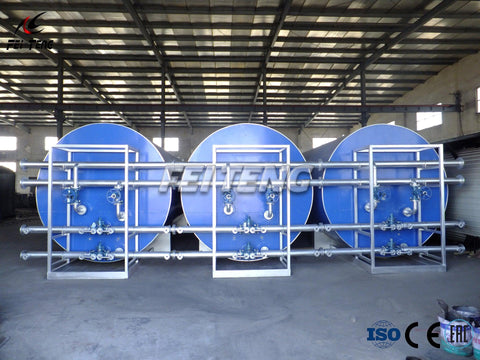
비투멘 탱크 | FEITENG
GerryJarl공유하다
현대 도로 건설에서 아스팔트 탱크는 아스팔트 콘크리트 혼합 시스템 내에서 핵심 구성 요소로 자리 잡고 있습니다. 빠른 가열 속도, 에너지 효율성 및 작동 용이성으로 인해 도로 건설 프로젝트에서 없어서는 안 될 요소가 되었습니다. 이 기사에서는 아스팔트 탱크의 특성, 구조적 구성, 가열 방법, 사용 및 유지 관리를 자세히 살펴보고 도로 건설에서의 적용에 대한 포괄적인 개요를 제공합니다.

I. 제품 특성
아스팔트 탱크는 뛰어난 성능으로 다른 아스팔트 장비와 차별화됩니다. 첫째, 빠른 가열 속도를 자랑하며, 첨단 가열 기술을 활용하여 아스팔트를 원하는 온도로 빠르게 상승시켜 생산 효율성을 크게 향상시킵니다. 게다가, 최적화된 설계와 효율적인 가열 시스템을 통해 이러한 탱크는 가열 과정에서 에너지 소비를 크게 줄여 사용자의 에너지 비용을 절감합니다. 특히, 가열 및 보관 중에 유해 가스나 물질을 생성하지 않아 현대 환경 표준을 완벽하게 준수합니다.
또한 아스팔트 탱크에는 자동 예열 시스템 및 자동 순환 프로그램과 같은 지능형 제어 시스템이 장착되어 있어 운영이 간소화됩니다. 또한 보관, 혼합 및 운송을 포함한 여러 기능을 제공하여 다양한 건설 수요에 유연하게 대응하고 도로 건설에 대한 포괄적인 지원을 제공합니다.
II. 구조 구성
아스팔트 탱크는 탱크 본체, 가열 장치, 아스팔트 펌프 시스템, 집진기, 유도 통풍 팬, 아스팔트 온도 디스플레이, 수위 표시기 등 다양한 구성 요소로 구성된 컴팩트하면서도 복잡한 구조를 자랑합니다. 이러한 부품은 세심하게 설계 및 설치되어 컴팩트하고 통합된 구조를 형성하여 장비 안정성과 향상된 운영 효율성을 보장합니다. 특히 가열 장치는 다재다능하여 사용자가 연료유, 가스, 전기, 열유 등 다양한 가열 방법을 선택할 수 있어 최적의 아스팔트 보관 및 가열 조건을 보장합니다.
III. 가열 방법
아스팔트 탱크는 다양한 가열 방법을 사용하는데, 각각 장단점이 있습니다. 연료유 가열은 빠른 가열 속도와 간단한 장비로 인기가 있습니다. 가스 가열은 환경 친화성, 청결성, 효율성이 뛰어납니다. 전기 가열은 정밀한 온도 제어와 작동의 용이성을 자랑하지만 전력 공급과 비용에 제약을 받을 수 있습니다. 열유 가열은 균일한 가열과 안정적인 온도 제어로 유명하지만 투자 비용이 더 많이 듭니다. 사용자는 가열 속도, 환경 영향, 비용, 안전성과 같은 요인에 따라 가장 적합한 방법을 선택할 수 있습니다.
가열 방법을 선택할 때 가열 속도, 환경 친화성, 비용 및 안전성과 같은 요소를 종합적으로 고려하는 것이 중요합니다. 선택한 방법에 관계없이 장비의 정상적인 작동과 안전한 사용을 보장하는 것은 보관 및 가열된 아스팔트의 품질을 보호하는 데 필수적입니다.
IV. 사용 및 유지 관리
아스팔트 탱크의 적절한 사용 및 유지관리는 아스팔트 품질을 유지하고 건설 효율성을 높이는 데 필수적입니다. 사용하기 전에 철저한 검사를 실시하여 안전한 연결, 유연한 작동 부품, 방해받지 않는 파이프라인 및 올바른 전원 배선을 보장해야 합니다. 난방 장치, 펌프 시스템, 파이프라인 및 기타 중요 구성 요소에 대한 누출, 막힘 및 마모에 대한 정기적인 검사도 중요합니다.
가열하는 동안 아스팔트 유형과 요구 사항에 따라 적절한 가열 방법과 온도 범위를 선택하는 것이 중요합니다. 점진적인 온도 상승은 급격한 온도 변화로 인한 품질 문제를 방지합니다. 또한 아스팔트 온도를 정기적으로 모니터링하면 원하는 범위 내에 유지됩니다.
유지관리에는 먼지와 흙을 제거하기 위해 탱크의 내부와 외부를 정기적으로 청소하여 청결을 유지하는 것이 포함됩니다. 마모된 부품은 장기적으로 안정적인 작동을 유지하기 위해 즉시 교체해야 합니다. 마지막으로, 화재 및 폭발과 같은 사고를 방지하기 위해 안전 작동 절차를 준수하는 것이 필수적입니다.
V. 시장 전망
도로 건설이 진행되고 기술이 발전함에 따라 아스팔트 탱크 시장은 상당한 성장 기회를 예상합니다. 향후 개발은 에너지 효율성, 환경 보호 및 지능형 제어를 우선시하여 더욱 엄격한 환경 규정과 건설 수요를 충족할 것입니다. 시장 경쟁이 심화되고 기술 혁신이 지속됨에 따라 아스팔트 탱크는 성능과 품질을 더욱 향상시킬 준비가 되었습니다.
결론적으로, 도로 건설의 중요한 도구로서 아스팔트 탱크의 효율성, 환경 친화성, 다기능성은 도로 공사에 대한 강력한 지원을 제공합니다. 그들은 앞으로도 계속해서 중요한 역할을 할 것이며 도로 건설 노력의 발전에 크게 기여할 것입니다.




